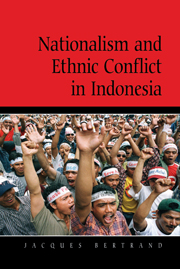Book contents
- Frontmatter
- Contents
- List of figures and tables
- Preface
- Maps
- 1 Introduction
- 2 Critical junctures, nationalism, and ethnic violence
- 3 The national model and its institutional history
- 4 Exclusion, marginality, and the nation
- 5 Islam and nation: The Muslim–Christian dimension
- 6 The escalation of religious conflict
- 7 Conflict in Maluku
- 8 Late integration into the nation: East Timor and Irian Jaya (Papua)
- 9 Aceh's ethnonationalist conflict
- 10 Autonomy as a solution to ethnic conflict
- 11 Unity in diversity
- Notes
- Glossary
- Bibliography
- Index
- CAMBRIDGE ASIA–PACIFIC STUDIES
2 - Critical junctures, nationalism, and ethnic violence
Published online by Cambridge University Press: 10 December 2009
- Frontmatter
- Contents
- List of figures and tables
- Preface
- Maps
- 1 Introduction
- 2 Critical junctures, nationalism, and ethnic violence
- 3 The national model and its institutional history
- 4 Exclusion, marginality, and the nation
- 5 Islam and nation: The Muslim–Christian dimension
- 6 The escalation of religious conflict
- 7 Conflict in Maluku
- 8 Late integration into the nation: East Timor and Irian Jaya (Papua)
- 9 Aceh's ethnonationalist conflict
- 10 Autonomy as a solution to ethnic conflict
- 11 Unity in diversity
- Notes
- Glossary
- Bibliography
- Index
- CAMBRIDGE ASIA–PACIFIC STUDIES
Summary
Ethnic conflict is shaped and mediated by the institutional context in which it occurs. Political institutions have a direct impact on the development of ethnic identity, its use in political mobilization, as well as the means available to negotiate group claims. They define citizens and non-citizens, majorities and minorities, and the allocation of political and economic resources. They define or deny group rights while also delimiting the means available to advance group interests.
Ethnic identities are malleable, multiple, and not always politicized. Identities defined in racial, religious, and cultural terms may be fixed over long periods of time but they can also change. Voluntary or forced conversion, conquest and redefinition of political boundaries, or colonial policies are all examples of events that can reshape them. Furthermore, any single individual possesses multiple, overlapping ethnic identities as a member of a religious, cultural, or regional group. Which identity becomes a stronger source of group differentiation may vary from one set of circumstances to another. Even more so, these identities do not necessarily become sources of competition for resources, access to the state, or conflict. While group differentiation may be prevalent, it may not have an impact on the structure of socio-political organizations or the character of political mobilization.
Political institutions are part of the context that shapes ethnic identity and mediates conflict. Differences in electoral systems might provide varied incentives to mobilize ethnic identity, sometimes even contributing to the formation of ethnic political parties.
- Type
- Chapter
- Information
- Nationalism and Ethnic Conflict in Indonesia , pp. 9 - 27Publisher: Cambridge University PressPrint publication year: 2003



